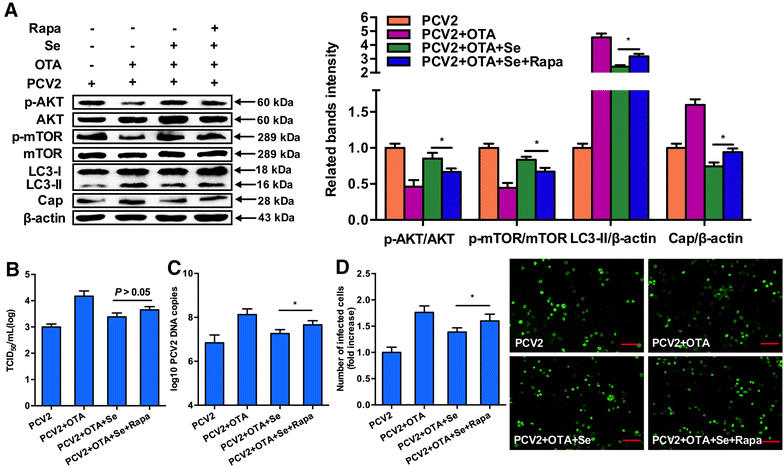SeMet attenuates OTA-induced PCV2 replication promotion by inhibiting autophagy by activating the AKT/mTOR signaling pathway
- PMID: 29439710
- PMCID: PMC5812231
- DOI: 10.1186/s13567-018-0508-z
SeMet attenuates OTA-induced PCV2 replication promotion by inhibiting autophagy by activating the AKT/mTOR signaling pathway
Abstract
Porcine circovirus type 2 (PCV2) is recognized as the causative agent of porcine circovirus-associated diseases. PCV2 replication could be promoted by low doses of ochratoxin A (OTA) as in our previous study and selenium has been shown to attenuate PCV2 replication. However, the underlying mechanism remains unclear. The aim of the study was to investigate the effects of selenomethionine (SeMet), the major component of organic selenium, on OTA-induced PCV2 replication promotion and its potential mechanism. The present study demonstrates that OTA could promote PCV2 replication as measured by cap protein expression, viral titer, viral DNA copies and the number of infected cells. In addition, OTA could activate autophagy as indicated by up-regulated light chain 3 (LC3)-II and autophagy-related protein 5 expressions and autophagosome formation. Further, OTA could down-regulate p-AKT and p-mTOR expressions and OTA-induced autophagy was inhibited when insulin was applied. SeMet at 2, 4 and 6 μM had significant inhibiting effects against OTA-induced PCV2 replication promotion. Furthermore, SeMet could attenuate OTA-induced autophagy and up-regulate OTA-induced p-AKT and p-mTOR expression inhibition. Rapamycin, an inhibitor of AKT/mTOR, could reverse the effects of SeMet on OTA-induced autophagy and the PCV2 replication promotion. In conclusion, SeMet could block OTA-induced PCV2 replication promotion by inhibiting autophagy by activating the AKT/mTOR pathway. Therefore, SeMet supplementation could be an effective prophylactic strategy against PCV2 infections and autophagy may be a potential marker to develop novel anti-PCV2 drugs.
Figures






Similar articles
-
Taurine attenuates OTA-promoted PCV2 replication through blocking ROS-dependent autophagy via inhibiting AMPK/mTOR signaling pathway.Chem Biol Interact. 2018 Dec 25;296:220-228. doi: 10.1016/j.cbi.2018.10.005. Epub 2018 Oct 14. Chem Biol Interact. 2018. PMID: 30332612
-
Ochratoxin A-induced autophagy in vitro and in vivo promotes porcine circovirus type 2 replication.Cell Death Dis. 2017 Jun 29;8(6):e2909. doi: 10.1038/cddis.2017.303. Cell Death Dis. 2017. PMID: 28661479 Free PMC article.
-
Selenizing astragalus polysaccharide attenuates PCV2 replication promotion caused by oxidative stress through autophagy inhibition via PI3K/AKT activation.Int J Biol Macromol. 2018 Mar;108:350-359. doi: 10.1016/j.ijbiomac.2017.12.010. Epub 2017 Dec 5. Int J Biol Macromol. 2018. PMID: 29217185
-
Overexpression of pig selenoprotein S blocks OTA-induced promotion of PCV2 replication by inhibiting oxidative stress and p38 phosphorylation in PK15 cells.Oncotarget. 2016 Apr 12;7(15):20469-85. doi: 10.18632/oncotarget.7814. Oncotarget. 2016. PMID: 26943035 Free PMC article.
-
Adapting the Stress Response: Viral Subversion of the mTOR Signaling Pathway.Viruses. 2016 May 24;8(6):152. doi: 10.3390/v8060152. Viruses. 2016. PMID: 27231932 Free PMC article. Review.
Cited by
-
Protective and detoxifying effects conferred by selenium against mycotoxins and livestock viruses: A review.Front Vet Sci. 2022 Aug 2;9:956814. doi: 10.3389/fvets.2022.956814. eCollection 2022. Front Vet Sci. 2022. PMID: 35982930 Free PMC article. Review.
-
Risk assessment of ochratoxin A in food.EFSA J. 2020 May 13;18(5):e06113. doi: 10.2903/j.efsa.2020.6113. eCollection 2020 May. EFSA J. 2020. PMID: 37649524 Free PMC article.
-
Antiviral Effect of Selenomethionine on Porcine Deltacoronavirus in Pig Kidney Epithelial Cells.Front Microbiol. 2022 Feb 15;13:846747. doi: 10.3389/fmicb.2022.846747. eCollection 2022. Front Microbiol. 2022. PMID: 35242124 Free PMC article.
-
Chondroitin Sulfate A-Selenium Nanoparticles Activate Autophagy Through the AMPK-mTOR Pathway to Alleviate Oxidative Stress and Mitochondrial Dysfunction to Repair Kashin-Beck Disease Chondrocytes.Biol Trace Elem Res. 2025 Jul 15. doi: 10.1007/s12011-025-04732-9. Online ahead of print. Biol Trace Elem Res. 2025. PMID: 40663290
-
Seleno-Metabolites and Their Precursors: A New Dawn for Several Illnesses?Metabolites. 2022 Sep 16;12(9):874. doi: 10.3390/metabo12090874. Metabolites. 2022. PMID: 36144278 Free PMC article. Review.
References
-
- Todd D, Bendinelli M, Biagini P, Hino S, Mankertz A, Mishiro S, Niel C, Okamoto H, Raidal S, Ritchie BW, Teo GC (2005) Virus taxonomy, 8th report of the International Committee for the taxonomy of viruses. pp 327–334
Publication types
MeSH terms
Substances
LinkOut - more resources
Full Text Sources
Other Literature Sources
Miscellaneous

